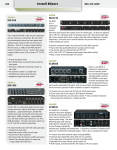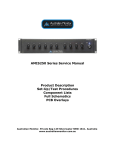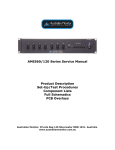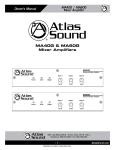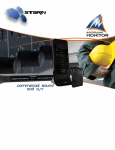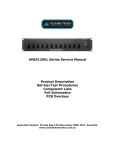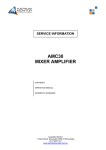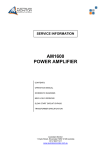Download AUSTRALIAN MONITOR IC30 Series Service manual
Transcript
IC30 Series Service Manual Product Description Set-Up/Test Procedures Component Lists Full Schematics PCB Overlays Australian Monitor. Private Bag 149 Silverwater NSW 1811. Australia www.australianmonitor.com.au IC30 Circuit Description The IC30 is a 30 watt mixer amplifier which operates on 230/240 VAC, 50Hz or 12 VDC via an external DC power supply source. The amplifier is supplied free standing with rubber feet but can be rack mounted via an optional rack mount kit (IC30RMK). The IC30 will deliver 30 watts into a load of 4 ohms, 70 volt or 100 volt line. The IC30 may be stacked to a maximum of four units high. An IEC type mains cord and receptacle are provided, the receptacle also houses the mains fuse in a drawer which pulls open to expose the fuse. A single spare fuse is also located in this drawer. AC Power Inlet The 3 pin IEC power inlet is located on the bottom left of the rear panel and accepts a standard mains power lead fitted with an IEC connector. Before plugging in a power lead, please check the rear panel of the amplifier to ensure that the voltage switch is set correctly for your part of the world. The operating voltage is 230/240 VAC @ 50 Hz. The inlet is equipped with an inbuilt AC fuse holder fitted with a 1 amp plus a spare within the holder]. Power consumption is approximately 60 VA. 12 Volt DC Operation The IC30 features optional 12VDC power to run off a battery supply if required. This is connected via the rear terminal strip. The front panel Power Switch will not switch DC power ‘on’ or ‘off’ in DC operation. In this mode the amplifier is always ‘on’. When running from 12 VDC power, the LED will not illuminate. There is no trickle charge resistor across the diode. 230V/240V Slide Switch The operating voltage of the amplifier is user selectable between 230V and 240V via a slide switch located on the top left side of the rear panel. This switch should be set to match the AC voltage of your country. The mains transformer is wound with a 230V winding plus a 10V winding internally connected. Power Amp The IC30 uses two(2) Philips amplifier ICs (TDA1516) with built in current overload and thermal protection. The two amplifier modules are capacitively coupled to the two primary windings of the output transformer in parallel (not in bridge). Speaker Output Terminal Strip The screw terminals in the middle of the strip allow access to the direct speaker outputs of the amplifier. Reading from left to right the terminals are: COM 4 Common or “-” for low impedance speaker loads (4 or 8 ohms). Positive “+” for 4 ohm speaker loads (use with common) COM 70 100 Common or “-” for 70v or100v speaker loads (maximum load of 80 ohms at 100v) Positive “+” for 70v line speaker loads (use with common) Positive “+” for 100v line speaker loads (use with common) Please ensure that the correct “Common” is used. Low impedance and 70/100v loads can be used simultaneously but please pay careful attention to the overall speaker load. Note: The minimum impedance (or maximum load) at 100 volt line should be no less than 80 Ohms Muting The last two(2) terminals on the barrier strip are for muting. Channels 2 and 3 are muted when the two mute contacts are shorted together. The muting is done by a FET switch so there is no ramping. An optional VOX muting module (TX3010) is also available with has ramping. Phantom Power The IC30 does not have phantom power on the XLR’s. Tape Output A mono RCA output connector provides a line level output with a maximum of 350mV into 10k Ohms. Signal from all three input channels are fed to the tape output. Level adjustments made to the three input channels will affect the level going to the tape output. Microphone/Line Inputs Three universal microphone/line inputs are provided. Microphone inputs are via the 3 pin XLR connectors while line inputs are via the RCA style connectors (one of each is provided per channel). All three inputs can be used for microphone and auxiliary input sources. It is also possible to connect both a microphone and line/aux source to the one channel simultaneously however their relative levels to one another will be fixed, as there is only one gain control per channel. The XLR connectors are wired: Pin 1: Earth. Pin 2: Active (high, +), Pin 3: Active (low, -). Microphone input sensitivity is 1.5mV at 200 ohms. The RCA connectors have an input sensitivity of 80mV at 47K ohms. Microphone Inputs All three(3) inputs are dual mic/line with microphone inputs being via a 3 pin XLR connector per channel. The mic input sensitivity is 1.5mV @ 200 ohms. Pin connections are: pin 1-earth; pin 2-signal (hot +); pin 3-signal (cold -). Phantom power is not available. Reading from left to right across the rear panel, the inputs are 3, 2, & 1. Line Inputs All three(3) inputs are dual mic/line with line/auxiliary inputs being via mono RCA connectors per channel. Line input sensitivity is 75mV @ 47K ohms. Reading from left to right across the rear panel, the inputs are 3, 2, & 1. Optional Accessories Tone Generators Four separate tones are available as an optional plug in card (ATC5488). The ATC5488 is a small circuit board which simply plugs into a socket inside the amplifier. Activation is via contact closures which may be wired to the rear panel of the IC30 or to external switches or a timer. Full installation instructions are provided with the tone generator. Tones available on the ATC5488 tone generator board are: Evacuation Tone (to Australian Standard AS2220.1.2) Alert Tone (to Australian Standard AS2220.1.2) Bell TonePre Announce Chime VOX Muting Module An optional VOX muting module (TX3010) is available. When installed inside the amplifier, signal on channel 1 of the amplifier will automatcially mute channels 2 and 3. When there is no signal on channel 1, channels 2 and 3 will operate normally. Full installation instructions are provided with the TX3010. Rack Mouting Kit An optional rack mounting kit (IC30RMK) is available to mount the IC30 in a standard 19" equipment rack. Fuse Sizes Mains 230 VAC: 1 Amperes Slow Blow The DC fuse is located on the circuit board. This is a feature of the AMIS series amplifiers, which are equipped with a current limiting circuit preventing excessive DC currents, thus eliminating the risk of blowing high tension fuses. In the unlikely event that the DC fuse actuates, the output IC modules should be checked, as it is probable that the amplifier has been subjected to very extreme conditions. The DC fuses are 4A time lag fuses. C24 1u C25 LM1458 C5 1u R13 C10 1u +5V R42 50K 2 C13 1u 7 5 R14 4K7 R32 10K 1 R15 47K C11 330P AUX3 C15 1u R19 680R C16 1u R23 R31 6K8 1 2 R45 1K 3 IC3C 4066 7 1 3 C18 330P R21 22K +5V B C21 1u R24 4K7 4 R22 10R R25 47K 100V C 4 OHM R17 10K 10 11 8 +14VDC C34 47u 10R 6 R44 IC6 4 LM741 C30 0.47 C 13 IC4 C22 1u +10V R29 10K C19 1u C47 10u 9 1 +12V C50 10u 5 TDA1516 2 4 IC2A 2 C49 470u 68K R41 +5V 5 LM1458 C17 1u 8 R20 680R C 70V C33 47u 4 MIC3 9 C36 82P C37 1u 3 T2 IC5 TDA1516 R34 6K8 R48 1M 22K C46 10u 5 2 +10V C20 330P C45 10u C29 1200P R12 22K +5V R18 47k 13 R33 1K R43 50K C C31 0.47 R30 10K PIN 14 4066 IC3A 4066 IC1B 6 R47 10K R39 0R C28 0.03 R26 1K C14 1u 22K LM1458 C23 1u C27 1u 12 R16 100R D 7 10 R11 680R +10V +5V C12 330P C9 1u IC2B 6 12 MIC2 C8 1u +10V 13 R10 680R R4 22K R8 P2 47K C35 47u TAPE OUT 100P 5 R5 10R 8 R9 47k AUX2 R7 4K7 C26 1u 4 3 C4 330P C7 1u 1 R40 68K R27 47K 11 IC1A 2 8 +14VDC 7 22K LM1458 C3 1u 7 X7 X5 GRD 4 R3 680R D 6 7 R6 R49 100R 5 10R +14VDC 6 C2 1u MIC1 4 R50 3 R2 680R 3 C6 330P 6 AUX1 C1 1u 8 2 R1 47k 3 1 C32 47u P1 R28 0R D1 MUTE F2 4A SB B +14V +12V BATTERY F1 0.5A SB S1 R38 10R T1 V1 BD139 D2-D5 N1 R35 4K7 C40 C41 +10V C43 100u R36 1K D6 11V C42 470u +5V R37 1K 2200u 2200u A C39 2200u C38 2200u 240VAC A C44 47u Title Size A3 Date: File: 1 2 3 4 5 6 IC30 MIX/POWER PCB CD6168-1 D Number 4-Jul-2003 C:\AMIS604 Manual\CD6168-1.DDB 7 Revision Sheet of Drawn By: 1 8 SBG 1 IC30 Parts List Designator C1 C10 C11 C12 C13 C14 C15 C16 C17 C18 C19 C2 C20 C21 C22 C23 C24 C25 C26 C27 C28 C29 C3 C30 C31 C32 C33 C34 C35 C36 C37 C38 C39 C4 C40 C41 C42 C43 C44 C45 C46 C47 C49 C5 C50 C6 C7 C8 C9 D1 D2-D5 D6 F1 Part Type 1u 1u 330P 330P 1u 1u 1u 1u 1u 330P 1u 1u 330P 1u 1u 1u 1u 100P 1u 1u 0.03 1200P 1u 0.47 0.47 47u 47u 47u 47u 82P 1u 2200u 2200u 330P 2200u 2200u 470u 100u 47u 10u 10u 10u 470u 1u 10u 330P 1u 1u 1u 12V .5A Description Electrolytic capacitor 63V Electrolytic capacitor 63V Multi layer ceramic capacitor 100V Multi layer ceramic capacitor 100V Electrolytic capacitor 63V Electrolytic capacitor 63V Electrolytic capacitor 63V Electrolytic capacitor 63V Electrolytic capacitor 63V Multi layer ceramic capacitor 100V Electrolytic capacitor 63V Electrolytic capacitor 63V Multi layer ceramic capacitor 100V Electrolytic capacitor 63V Electrolytic capacitor 63V Electrolytic capacitor 63V Electrolytic capacitor 63V Multi layer ceramic capacitor 100V Electrolytic capacitor 63V Electrolytic capacitor 63V Multi layer ceramic capacitor 100V Multi layer ceramic capacitor 100V Electrolytic capacitor 63V Metalised Poly Capacitor Electrolytic capacitor 63V Electrolytic capacitor 35V Electrolytic capacitor 35V Electrolytic capacitor 35V Electrolytic capacitor 35V Multi layer ceramic capacitor 100V Electrolytic capacitor 63V Electrolytic capacitor 35V Electrolytic capacitor 35V Multi layer ceramic capacitor 100V Electrolytic capacitor 35V Electrolytic capacitor 35V Electrolytic capacitor 35V Electrolytic capacitor 100V Electrolytic capacitor 35V Electrolytic capacitor 50V Electrolytic capacitor 50V Electrolytic capacitor 50V Electrolytic capacitor 35V Electrolytic capacitor 63V Electrolytic capacitor 50V Multi layer ceramic capacitor 100V Electrolytic capacitor 63V Electrolytic capacitor 63V Electrolytic capacitor 63V Diode 1N5408 Diode 1N5408 Zener Diode 1W 12V 1N4742 0.5 Amp Anti-surge Fuse Manufacturer's Code 2121280010 2121280010 2127181331 2127181331 2121280010 2121280010 2121280010 2121280010 2121280010 2127181331 2121280010 2121280010 2127181331 2121280010 2121280010 2121280010 2121280010 2127181101 2121280010 2121280010 2124292330 2127181122 2121280010 2124262472 2124262472 2121230470 2121230470 2121230470 2121230470 2127181820 2121280010 2121220222 2121220222 2127181331 2121220222 2121220222 2121230471 2121220101 2121230470 2121250100 2121250100 2121250100 2121230471 2121280010 2121250100 2127181331 2121280010 2121280010 2121280010 2133450408 2133450408 2136010120 2543210059 F2 IC1 IC2 IC3 IC4 IC5 IC6 P1 P2 R1 R10 R11 R12 R13 R14 R15 R16 R17 R18 R19 R2 R20 R21 R22 R23 R24 R25 R26 R27 R28 R29 R3 R30 R31 R32 R33 R34 R35 R36 R37 R38 R39 R4 R40 R41 R42 R43 R44 R45 R47 R48 R49 R5 R50 R6 4.0A LM1458 LM1458 4066 TDA1516 TDA1516 LM741 X7 X5 47k 680R 680R 22K 22K 4K7 50K 100R 10K 47k 680R 680R 680R 22K 10R 22K 4K7 50K 1K 47K 0R 10K 680R 10K 6K8 10K 1K 6K8 4K7 1K 1K 10R 0R 22K 68K 68K 50K 50K 10R 1K 10K 1M 100R 10R 10R 22K 4.0 Amp Anti-surge Fuse IC Dual Op Amp DIP8 IC Dual Op Amp DIP8 I.C. CD 4066BCN VCA (14 PIN) Amplifier IC TDA1516BQ Amplifier IC TDA1516BQ LM741 IC Transistor BD139 Transistor BD139 Resistor, metalfilm .5W Resistor, metalfilm .5W Resistor, metalfilm .5W Resistor, metalfilm .5W Resistor, metalfilm .5W Resistor, metalfilm .5W Potentiometer linear Resistor, metalfilm .5W Resistor, metalfilm .5W Resistor, metalfilm .5W Resistor, metalfilm .5W Resistor, metalfilm .5W Resistor, metalfilm .5W Resistor, metalfilm .5W Resistor, metalfilm .5W Resistor, metalfilm .5W Resistor, metalfilm .5W Potentiometer linear Resistor, metalfilm .5W Resistor, metalfilm .5W Resistor, metalfilm .5W Resistor, metalfilm .5W Resistor, metalfilm .5W Resistor, metalfilm .5W Resistor, metalfilm .5W Resistor, metalfilm .5W Resistor, metalfilm .5W Resistor, metalfilm .5W Resistor, metalfilm .5W Resistor, metalfilm .5W Resistor, metalfilm .5W Resistor, metalfilm .5W Resistor, metalfilm .5W Resistor, metalfilm .5W Resistor, metalfilm .5W Resistor, metalfilm .5W Potentiometer linear Resistor, metalfilm .5W Resistor, metalfilm .5W Resistor, metalfilm .5W Resistor, metalfilm .5W Resistor, metalfilm .5W Resistor, metalfilm .5W Resistor, metalfilm .5W Resistor, metalfilm .5W Resistor, metalfilm .5W 2541210840 2152870558 2152870558 2159440066 2153121516 2153121516 2152080741 2141400139 2141400139 9111590473 9111590681 9111590681 9111590223 9111590223 9111590472 2021000503 9111590101 9111590103 9111590473 9111590681 9111590681 9111590681 9111590223 9111590100 9111590223 9111590472 2021000503 9111590102 9111590473 9111590000 9111590103 9111590681 9111590103 9111590682 9111590103 9111590102 9111590682 9111590472 9111590102 9111590102 9111590100 9111590000 9111590223 9111590683 9111590683 2021000503 2021000503 9111590100 9111590102 9111590103 9111590104 9111590101 9111590100 9111590100 9111590223 R7 R8 R9 S1 4K7 50K 47k Resistor, metalfilm .5W Potentiometer linear Resistor, metalfilm .5W Rocker switch SPST 9111590472 2021000503 9111590473 2511213112 WORK INSTRUCTION Testing of IC 30 1. Perform physical inspection ( Visual Inspection stage ) 1.1 Check : • All screws for tightness ( esp. H/S & IC fixing). • Capacitors for polarity. • Earth connection for good contact (XLR gnd to AC earth), including earthing of RCA’s, • All wiring points for good contacts (Soldering and Crimping) 2. Set up amplifier for test (Pre (PCB testing) ). 2.1 Connect amplifier to : • Variac (0 Vac) • Signal generator (Mic 1, no signal), • Resistive load (4ohm on 4ohm output). 2.2 Reset controls : • Volume controls to minimum, • Bass/treble control to center, • Phantom power switch to off, 3. Power up (Pre (PCB testing). 3.1 Turn on power switch and adjust voltage to 120VAC. Watch current meter for excess current draw. 3.2 Check DC power supply at fuse. Should be approximately. 7V ( + 1V ) 3.3 Check DC voltage on mixer board. Should be approximately. 6V (Check on 8 No. Pin of 1458). 3.4 Adjust variac to 240VAC. Check DC power supply. Should be approx. 15V (+ 1V) loaded, no load (16.5V + 1V). 3.5 Check DC voltage on mixer board. Should be approx. (11V + 1V). 4. AC Check (Final stage). 4.1 Set signal generator to (1mV) + 0.2mV. Turn up Mic1 volume control to full. Watch for irregularities with output. Check sensitivity of input. – MIC 1mV (+ 0.2mV) in 10.5Vrms out (2.6% THD). 4.2 Measure 100V line, 70V line, tol. 5% 4.3 Check tape output (0.4V + 100mV). 4.4 Check Bass control @100HZ = + 12dB (can get only upto 8V O/P with total swing of (20 – 24dB) ) and treble @10KHz = + 10dB (tolerance. 10%) total swing (18 – 22dB). 5. Function Checks (Final stage). 5.1 Move signal generator to Mic2. Turn up volume control. Watch for irregularities. Check for 10.5V out. 5.2 Move signal generator to Mic3. Turn up volume control. Watch for irregularities. Check for 10.5V out. 6. Line level inputs (Final stage). 6.1 Connect signal generator to Line1 input. Check input sensitivity – LINE (85mV + 20mV) in 10.5V out. 6.2 Move signal generator to Line2 input. Check 10.5V out. 6.3 Move signal generator to Line3 input. Check 10.5V out. 6.4 Check muting function by shorting mute terminals on rear barrier strip. 6.5 Check operation of (230 – 240)V selector switch for full wattage in each position of switch. 6.6 Frequency Response – Check the frequency response and power bandwidth of 1st set of every new batch of production. Frequency Response – (250Hz – 10kHz). Power band – (250Hz – 6.5kHz). 7. Finishing up (Final stage). 7.1 Short output and check that signal cuts out and returns after short is removed. 7.2 Remove input signal and check for Hum and Noise (<20m Vrms) 7.3 Connect 12V DC to rear barrier strip, turn off power switch. Check signal remains. 7.4 Reset volumes to minimum. 7.5 Disconnect from test bench and inspect for scratches on external paint. 8. Burn In. 8.1 Leave units on (with lid) for 24 hrs. 9. Sound Test (Check Fuse Ratings). 9.1 Adjust tone controls to minimum. and maximum listening for scratches and irregularities. Similarly for each level control with MASTER full. 9.2 Connect CD player to Line4 and bring up channel and master volumes. 9.3 Listen for irregularities. 9.4 Check priority of (MIC1 and MIC2) over all other channels. 9.5 Check all the tones. WORK INSTRUCTION Testing of IC 30 1. Perform physical inspection ( Visual Inspection stage ) 1.1 Check : • All screws for tightness ( esp. H/S & IC fixing). • Capacitors for polarity. • Earth connection for good contact (XLR gnd to AC earth), including earthing of RCA’s, • All wiring points for good contacts (Soldering and Crimping) 2. Set up amplifier for test (Pre (PCB testing) ). 2.1 Connect amplifier to : • Variac (0 Vac) • Signal generator (Mic 1, no signal), • Resistive load (4ohm on 4ohm output). 2.2 Reset controls : • Volume controls to minimum, • Bass/treble control to center, • Phantom power switch to off, 3. Power up (Pre (PCB testing). 3.1 Turn on power switch and adjust voltage to 230VAC. Watch current meter for excess current draw. 3.2 Check DC power supply at fuse. Should be approximately. 7V ( + 1V ) 3.3 Check DC voltage on mixer board. Should be approximately. 6V (Check on 8 No. Pin of 1458). 3.4 Adjust variac to 240VAC. Check DC power supply. Should be approx. 15V (+ 1V) loaded, no load (16.5V + 1V). 3.5 Check DC voltage on mixer board. Should be approx. (11V + 1V). 4. AC Check (Final stage). 4.1 Set signal generator to (1mV) + 0.2mV. Turn up Mic1 volume control to full. Watch for irregularities with output. Check sensitivity of input. – MIC 1mV (+ 0.2mV) in 10.5Vrms out (2.6% THD). 4.2 Measure 100V line, 70V line, tol. 5% 4.3 Check tape output (0.4V + 100mV). 4.4 Check Bass control @100HZ = + 12dB (can get only upto 8V O/P with total swing of (20 – 24dB) ) and treble @10KHz = + 10dB (tolerance. 10%) total swing (18 – 22dB). 5. Function Checks (Final stage). 5.1 Move signal generator to Mic2. Turn up volume control. Watch for irregularities. Check for 10.5V out. 5.2 Move signal generator to Mic3. Turn up volume control. Watch for irregularities. Check for 10.5V out. 6. Line level inputs (Final stage). 6.1 Connect signal generator to Line1 input. Check input sensitivity – LINE (85mV + 20mV) in 10.5V out. 6.2 Move signal generator to Line2 input. Check 10.5V out. 6.3 Move signal generator to Line3 input. Check 10.5V out. 6.4 Check muting function by shorting mute terminals on rear barrier strip. 6.5 Check operation of (230 – 240)V selector switch for full wattage in each position of switch. 6.6 Frequency Response – Check the frequency response and power bandwidth of 1st set of every new batch of production. Frequency Response – (250Hz – 10kHz). Power band – (250Hz – 6.5kHz). 7. Finishing up (Final stage). 7.1 Short output and check that signal cuts out and returns after short is removed. 7.2 Remove input signal and check for Hum and Noise (<20m Vrms) 7.3 Connect 12V DC to rear barrier strip, turn off power switch. Check signal remains. 7.4 Reset volumes to minimum. 7.5 Disconnect from test bench and inspect for scratches on external paint. 8. Burn In. 8.1 Leave units on (with lid) for 24 hrs. 9. Sound Test (Check Fuse Ratings). 9.1 Adjust tone controls to minimum. and maximum listening for scratches and irregularities. Similarly for each level control with MASTER full. 9.2 Connect CD player to Line4 and bring up channel and master volumes. 9.3 Listen for irregularities. 9.4 Check priority of (MIC1 and MIC2) over all other channels. 9.5 Check all the tones.















